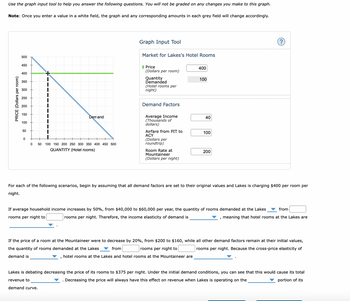Ab 38
Economics

Transcribed Image Text:Use the graph input tool to help you answer the following questions. You will not be graded on any changes you make to this graph.
Note: Once you enter a value in a white field, the graph and any corresponding amounts in each grey field will change accordingly.
PRICE (Dollars per room)
500
450
400
350
300
250
200
150
100
50
0
I
I
1
Demand
0 50 100 150 200 250 300 350 400 450 500
QUANTITY (Hotel rooms)
Graph Input Tool
Market for Lakes’s Hotel Rooms
Price
(Dollars per room)
Quantity
Demanded
(Hotel rooms per
night)
Demand Factors
Average Income
(Thousands of
dollars)
Airfare from PIT to
ACY
(Dollars per
roundtrip)
Room Rate at
Mountaineer
(Dollars per night)
400
100
40
100
200
For each of the following scenarios, begin by assuming that all demand factors are set to their original values and Lakes is charging $400 per room per
night.
If average household income increases by 50%, from $40,000 to $60,000 per year, the quantity of rooms demanded at the Lakes from
rooms per night to
rooms per night. Therefore, the income elasticity of demand is
, meaning that hotel rooms at the Lakes are
If the price of a room at the Mountaineer were to decrease by 20%, from $200 to $160, while all other demand factors remain at their initial values,
the quantity of rooms demanded at the Lakes from
rooms per night to
rooms per night. Because the cross-price elasticity of
demand is
hotel rooms at the Lakes and hotel rooms at the Mountaineer are
Lakes is debating decreasing the price of its rooms to $375 per night. Under the initial demand conditions, you can see that this would cause its total
revenue to
. Decreasing the price will always have this effect on revenue when Lakes is operating on the
portion of its
demand curve.
Note: Once you enter a value in a white field, the graph and any corresponding amounts in each grey field will change accordingly.
PRICE (Dollars per room)
500
450
400
350
300
250
200
150
100
50
0
I
I
1
Demand
0 50 100 150 200 250 300 350 400 450 500
QUANTITY (Hotel rooms)
Graph Input Tool
Market for Lakes’s Hotel Rooms
Price
(Dollars per room)
Quantity
Demanded
(Hotel rooms per
night)
Demand Factors
Average Income
(Thousands of
dollars)
Airfare from PIT to
ACY
(Dollars per
roundtrip)
Room Rate at
Mountaineer
(Dollars per night)
400
100
40
100
200
For each of the following scenarios, begin by assuming that all demand factors are set to their original values and Lakes is charging $400 per room per
night.
If average household income increases by 50%, from $40,000 to $60,000 per year, the quantity of rooms demanded at the Lakes from
rooms per night to
rooms per night. Therefore, the income elasticity of demand is
, meaning that hotel rooms at the Lakes are
If the price of a room at the Mountaineer were to decrease by 20%, from $200 to $160, while all other demand factors remain at their initial values,
the quantity of rooms demanded at the Lakes from
rooms per night to
rooms per night. Because the cross-price elasticity of
demand is
hotel rooms at the Lakes and hotel rooms at the Mountaineer are
Lakes is debating decreasing the price of its rooms to $375 per night. Under the initial demand conditions, you can see that this would cause its total
revenue to
. Decreasing the price will always have this effect on revenue when Lakes is operating on the
portion of its
demand curve.







